Comprehensive Tree Care Strategies for Urban Environments
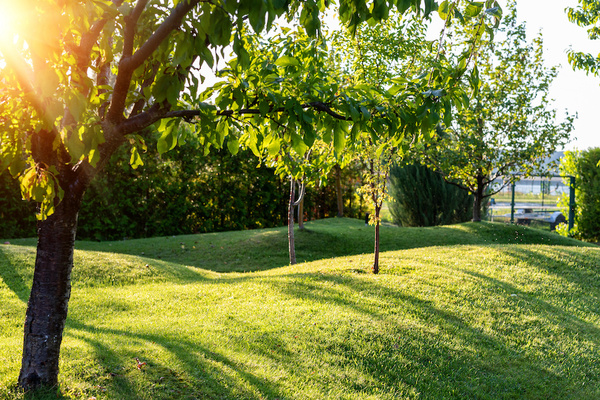
Introduction
Urban environments present unique challenges for tree care, but the importance of urban trees can’t be overstated. Trees contribute to cleaner air, improve mental health, and foster social cohesion. It’s crucial to adopt comprehensive tree care strategies for urban environments to ensure their survival in our bustling cities.
Here we will guide you through the process of selecting, planting, caring for, and maintaining urban trees for a greener, healthier future.
Urban Tree Selection and Planting
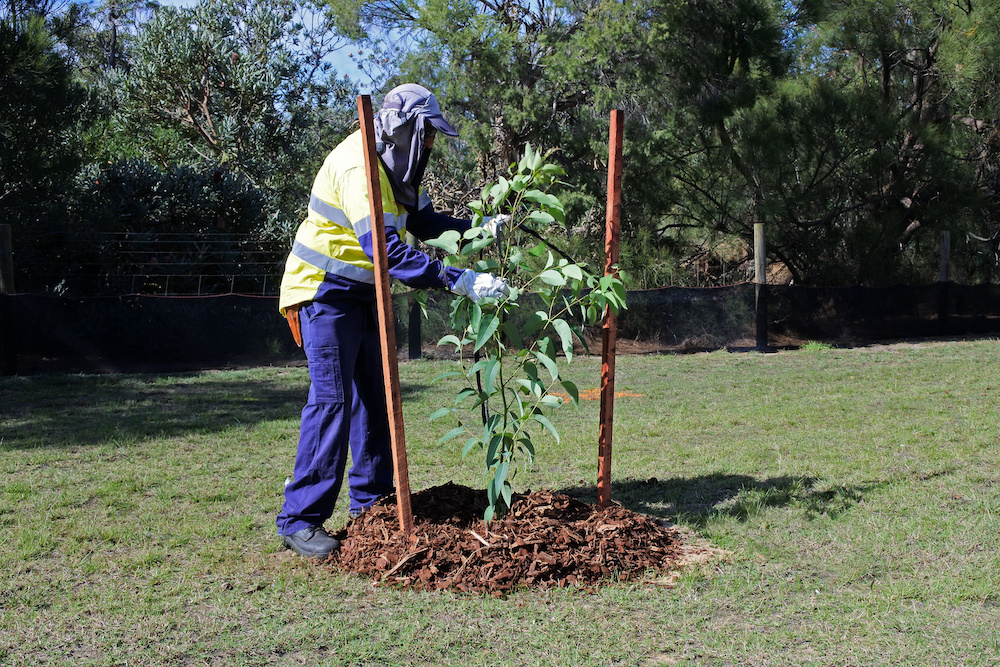
A Worker Plants, Stakes, and Mulches a Young Tree
Choosing the right tree species and planting them properly is the foundation of successful urban tree care. Factors like drought tolerance, soil compaction, and tree spacing should be considered for setting your trees on a path of long-term health and success in urban environments. Some factors to consider when choosing a tree species include:
- Heat stress tolerance
- Drought tolerance
- Sunlight exposure requirements
- Pest resistance
For example, maples in urban areas may experience issues with heat stress, drought, sunlight exposure, and pests, but proper pruning techniques can alleviate some of these challenges.
The health of urban trees depends heavily on proper tree planting and watering practices, which directly impact the tree’s root system.
Drought-Tolerant Trees
Drought-tolerant trees are ideal for urban environments where water resources may be limited. These trees are capable of enduring and prospering in arid conditions. The tree’s native environment, its water requirements, and its capacity to withstand drought conditions are key considerations when selecting drought-tolerant trees.
A certified arborist can provide guidance on the best drought-tolerant tree species for your area and help ensure their proper care.
Soil Compaction and Root Systems
Soil compaction can negatively impact tree growth in urban settings by:
- Hindering root development and growth
- Constraining the exploration of soil by roots
- Adversely influencing root system architecture
- Diminishing nutrient and water uptake by roots
- Obstructing oxygen supply to roots
To address soil compaction, consider adding organic matter to improve soil nutrients and microbiology. This contributes greatly to optimal tree growth and the development of a robust root system. In some cases, an air spade tool may be used for the remediation of soil compaction.
Tree Spacing and Sun Exposure
Optimal tree growth and development depend on proper tree spacing and sun exposure. These factors influence the amount of light, water, and nutrients available to the tree.
Hedge maple, rock maple, and hard maple are some of the most suitable trees for urban environments with limited sunlight. On the other hand, red maple, silver maple, and sugar maple are all suitable trees for urban environments with ample sun exposure.
Caring for Newly Planted Urban Trees
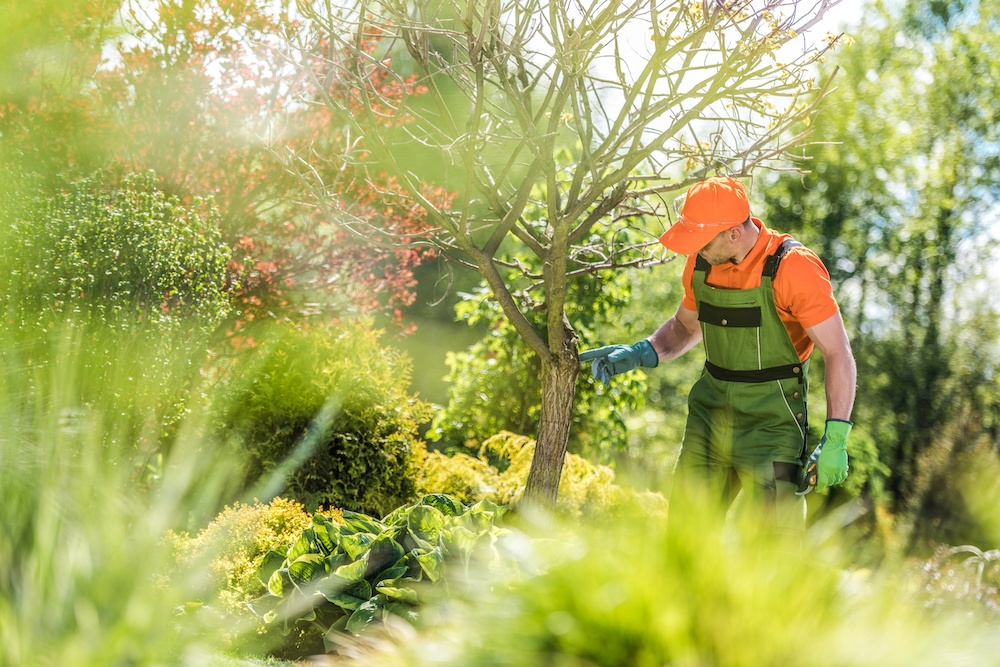
A Tree Care Specialist Checks the Health of a Small Tree
The well-being and long-term survival of newly planted urban trees depends on diligent care. Urban trees confront particular dangers, such as vehicle damage, air pollution, restricted space, and compacted soils.
Proper watering, mulching, and damage prevention practices are fundamental to ensure the health and longevity of urban trees. These practices can aid urban trees in flourishing and reduce the potential for injury or damage.
Watering Guidelines
The survival and growth of newly planted urban trees heavily depend on adequate hydration. For the initial couple of weeks after planting, newly planted trees should be watered once daily.
During the growing season, watering should be done once a week, with an approximate amount of 1 1/2 gallons of water per diameter inch of the trunk if the soil is dry.
Deep, slow waterings should be given at the base of the tree to properly hydrate roots. It is advisable to water plants in the early morning or late evening. This will help reduce evaporation.
Mulching Techniques
For newly planted trees, mulch offers many benefits like retaining soil moisture, suppressing weeds, and regulating soil temperature. Organic mulch is recommended for trees in hot weather. To ensure optimal benefit, the mulch should be spread evenly three inches away from the tree trunk.
Preventing Damage
The long-term health and survival of urban trees requires effective damage prevention. Tree guards are protective barriers that are placed around the base of a tree to safeguard it from damage caused by lawn mowers, weed whackers, and other mechanical equipment.
Additionally, they help protect the tree from animals, pests, and other environmental factors.
Pruning and Maintenance of Urban Trees
The health and safety of urban trees necessitates proper pruning and maintenance. Proper pruning techniques and addressing common tree issues can ensure long-term tree health and decrease the potential for property damage.
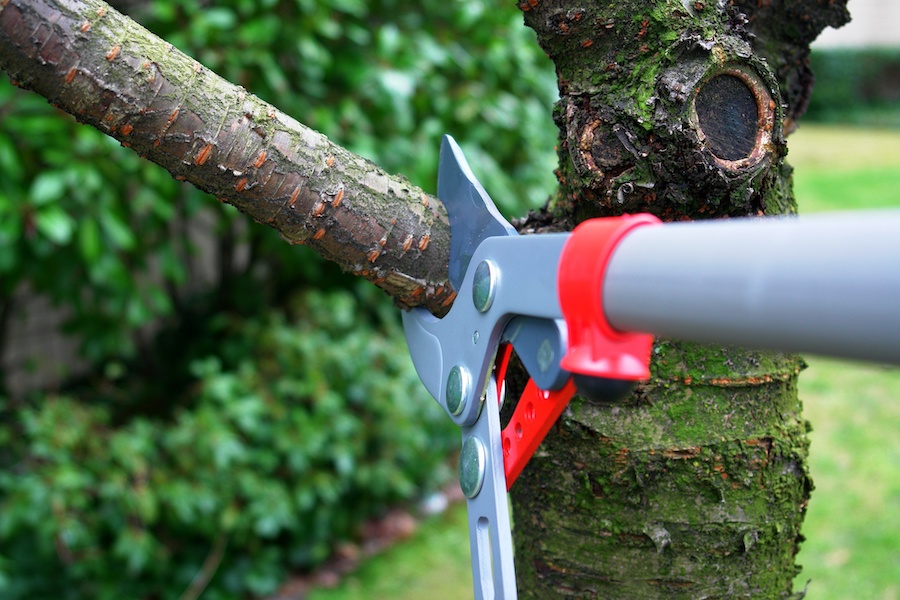
A Pruning Tool in Position to Correctly Prune a Branch
Pruning Basics
Maintaining tree health and appearance requires proper pruning. Cuts should be made carefully while pruning. Only branch wood should be removed, ensuring the trunk or supporting system remains unaffected.
This will minimize the risk of decay, as the tree can heal the wound more efficiently if only branch wood is removed and the wound is small.
To prune branches effectively, follow these steps:
- Make cuts just outside the branch bark ridge and angle down and slightly away from the stem, while being mindful to avoid injury to the branch collar.
- Utilize a series of three cuts to make the process more effective. The first two cuts remove the weight of the branch; one cuts from underneath and then the other cuts from above the branch.
- Finally, make a pruning cut to remove the branch.
Identifying and Addressing Common Tree Issues
Urban trees often face common issues such as:
- Environmental and man-made conditions
- Lightning strikes
- Stress from pollution, heat, and drought
- Soil compaction
- Wood-eating insects and decay
- Dead trees that may cause future problems
The long-term health of urban trees necessitates the recognition and resolution of these issues.
To mitigate common tree issues, it is recommended to:
- Select and plant trees appropriately
- Ensure adequate water and mulching
- Perform pruning and maintenance
- Remove and replace trees as necessary
Tending to these issues can guarantee long-term tree health, decrease the possibility of property damage, and offer environmental, social, and community advantages.
Certified Arborists' Role
The maintenance of urban trees and the provision of expert advice heavily rely on certified arborists. Tree care work is inherently hazardous and necessitates appropriate training to be completed safely. Qualified professionals can ensure the work is done safely and correctly to preserve the health of the tree.
Consulting a certified arborist for tree care, pruning, and removal ensures you are working with knowledgeable professionals who will advocate on behalf of your trees.
The average cost of hiring certified arborists ranges from $70 to $200 per hour. However, most arborists offer a flat rate per project. For instance, tree removal costs can range from $200 to $5,000 or more, depending on the size of the tree. Some lumber companies may even offer free tree removal in exchange for wood.
Urban Tree Removal and Replacement
Urban trees should be removed and replaced in a safe and responsible manner. Whether a tree needs to be removed due to safety concerns or poor health, it’s crucial to follow proper procedures and plant a suitable replacement tree to maintain the urban tree canopy.
When to Remove a Tree
It is necessary to remove a tree when it is deemed to be a safety hazard or is in a state of poor health. Safety concerns may arise from dead or dying branches, weak or leaning trunks, and root systems that are damaging nearby structures.
Indications of poor health in a tree include discolored or wilting leaves, sparse foliage, and visible signs of disease or insect infestation. If a tree needs removal, its replacement should be suitable for the environment.
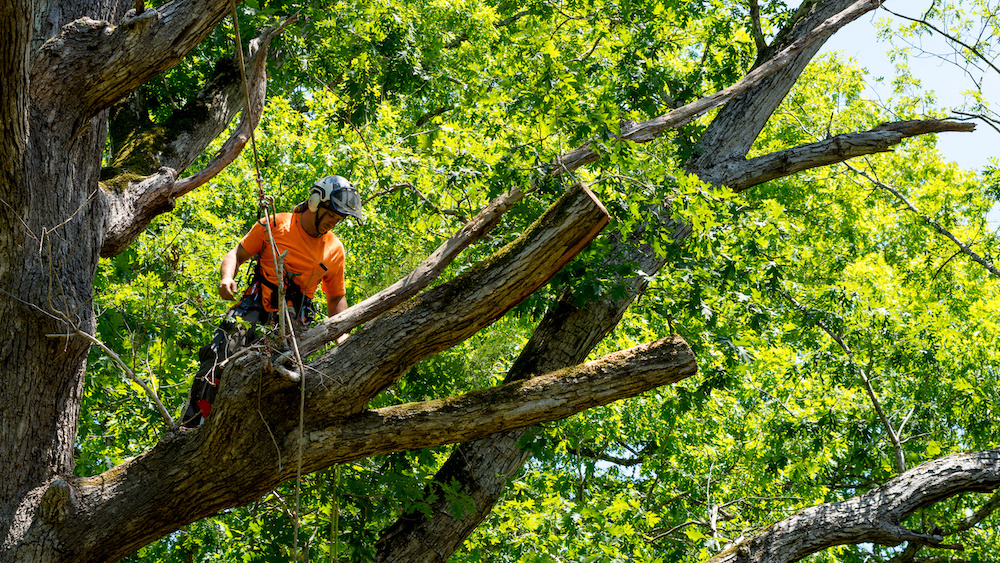
An Arborist Works to Safely Remove Large Branches
Safe Tree Removal Practices
Minimizing risks and damage requires adherence to safe tree removal practices. It is important to ensure that protective gear is worn, the appropriate tools are used, and a plan for the removal is in place when removing a tree. Specialized equipment required for tree removal consists of a chainsaw, a ladder, and rope.
The optimal pruning practices for tree removal involve:
- Eliminating dead or diseased branches
- Eliminating branches that are too close to buildings or power lines
- Eliminating branches that are too close to other trees
If a tree is large or is in a difficult location, it may be necessary to consult a certified arborist for tree removal. If you are a senior with a limited budget, you can look for free tree removal for seniors in your area.
Planting Replacement Trees
The urban tree canopy and its numerous environmental benefits are maintained by planting replacement trees. Suitable tree species for urban environments include:
- Bur Oak
- Desert willow
- Ash
- Maple
- Oak
- Pine
- Cherry
- Peach
- Plum
- Crabapple
These trees are known for their durability and tolerance of urban stresses and poor soils.
To plant a replacement tree, follow these steps:
- Select an appropriate tree for the site.
- Prepare the planting site.
- Plant the tree.
- Provide subsequent maintenance, including tasks like watering, mulching, pruning, and monitoring for pests and diseases.
Conclusion
Urban trees play a vital role in our communities, providing numerous environmental, social, and community benefits. By selecting appropriate tree species, planting them in suitable locations, and caring for them through proper pruning, watering, mulching, and maintenance techniques, we can ensure the health and longevity of our urban forests.





